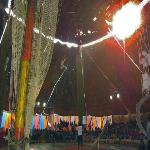July 11, 2011

Photo: VOA - I. Broadhead
A young Nepalese girl trains on the trapeze using poor safety equipment as rain leaks through the roof, in one of India's traveling circuses, in Dehradun, India, July 2011
India's traditional traveling circuses remain widely popular across the country, although attendance has been falling in recent years. Despite their popularity, there have long been concerns about their treatment of child circus performers, many of whom are trafficked from Nepal.
Starting this month, India's Supreme Court banned circus owners from using child performers and demanded that youngsters already working under the big top should be released. This correspondent recently traveled with a child welfare group that rescues minors from the circus life.
The circus has come to Dehradun, the state capital of Uttarakhand here in northern India. It is a big event in the town's social calendar. Hundreds of families have turned out to enjoy the festive atmosphere.
Child welfare organizations also are here. They believe that 23 children, some as young as seven, are being held against their will and being forced to perform five times a day.
Philip Holmes is director of the Esther Benjamins Trust. His team has rescued more than 400 abused and underage performers from Indian circuses since 2004.
"These are children essentially sold by their families to trafficking agents, who sell them on to circuses - effectively to a life of bondage and modern-day slavery," said Homes. "Training of the children is fueled by beatings. Sexual abuse has been extremely common - little girls, eight, nine [years-old] being raped. Those kids are under total control of the circus owner."
In April, India's Supreme Court found in a case brought by the New Delhi-based non-governmental organization, Bachpan Bachao Andolan, that such abuses are "rampant" in the circus industry.
This claim was denied by the owners of the country's 30-or-so travelling circuses that collectively are believed to employ more than 1,000 children below 18 years of age.
The court ordered that the government rescue every underage child performer in India, and rehabilitate them from treatment it referred to as "inhuman." The government had until the end of June to agree to comply.
Civil rights lawyer Nandita Rao said, "The Child Labour Act broadly prohibited the employment of children under 14 ‘in industry' ... and ‘industry' didn't include circuses. Now, the Supreme Court has recognized children working in circuses as completely illegal and ... raised the age from 14 to 18 - children under-18 cannot be employed in a circus. In many ways, that's radical."
In India, where many children work to support their families, there is still skepticism about the severity of the problem. When activists met with officials in Dehradun, some pondered the necessity of rescuing the children if, as the ringmasters claim, their performing financially supports families struggling to make ends meet.
Aditi Kur with Child Line India said the Supreme Court's ruling shuts down such excuses.
"Perhaps they're not aware of what child labor actually means, which is huge," said Kur. "The State has to come in and support these children so that they stop working, then ensure the children have some sort of education [to] be able to carry on a better life for themselves."
Two days later, the district magistrate has been advised that arrest warrants exist for the Dehradun circus owner on rape and assault charges, but an operation to rescue the children still has not taken place. Rao said involving local authorities can sometimes undermine the rescue operation.
"Certain states in the north and northeast of India, there is a lot of lawlessness. These circus criminals conduct a lot of other nefarious businesses," said Rao. "It's not difficult for them to make the children disappear ... with the connivance, possibly, of government officers."
On day three, the local authorities decide to act. But to the dismay of child welfare groups relegated to observing events from outside the circus, officials have no police backup to ensure the safety of the children - or to prevent the owner from spiriting them away:
One official said, "They've seen us..." [car door slams]
The correspondent elaborates on the unfolding scene. "We're running across the field. Government officials are inside the circus - we've just stopped six young girls who were being led out the back door."
During the chaos of the authorities' bungled operation, two circus employees attempt to secretly take seven of the youngest girls away from the circus compound, through a side gate. Staff from the Esther Benjamins Trust rush to stop and apprehend them.
The girls will be looked after at a government refuge before undergoing training to help rehabilitate them back into society. However, remaining unaccounted for are more than 12 other young performers.
After they are rescued, many children's parents cannot be located. For those left on their own, Holmes said the Esther Benjamins Trust has formed south Asia's first contemporary circus, with performances that combine traditional circus skills with dance and other performing arts.
"We've got kids we rescued, who were brutalized in the circuses, coming forward to take part," said Holmes. "They are thrilled to use this as a form of rehabilitation. They're confronting demons; getting a chance to live the dream that was sold to them falsely by traffickers many years ago."
The troupe - named Sapana after the Nepalese word for "Dream" - will be touring the Middle East later this year.